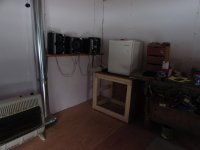Heaters, and doors, and ladders
Heat. Whatever the main source of heat I am a big fan of radiant oil heaters, and one of those would probably be enough to keep the shop comfortable in the winter, once the Mr. Monoxide propane heater was the shop warmed up.
I have had this radiant oil heater in the shop, mine badged as a DeLonghi but idential, and have used it for years. It is a durable beast, and throws out serious heat.
https://www.amazon.com/Tangkula-Ele...r=8-1-spons&keywords=radiant+oil+heater&psc=1
I actually have two radiant oil heaters. That DeLonghi beast in the main shop, currently turned off, one a crapty Walmart Lakewood badged version in the shop office, currently set at 600 watts, just to keep things warm while the office window is open for, um, fume reduction. The WallyWorld Lakewood is a POS, like most of their heating and cooling stuff. Never again.
The best part about those heaters is that, when you finish some epoxy, varnish or contact cement work last thing tackled in the evening you can turn them on low, positioned underneath a gunwales down canoe on sawhorses hull, and trap gobs of heat inside that overturned shell.
The shop space may end up near freezing in winter work, but the hull stays material set up warm for the cost of six hundred watt light bulbs. The last thing I do sequentially is the varnish, contact cement or epoxy work, and then it is time to walk away for the night. I love coming out the next morning to find things warm-ish, untacky dry and mostly cured.
Doors. Oh brutha, looking at the door gaps on that video, just wait until you get a well sealed and insulated shop door in place. I will open two of the shop windows, just an inch or two, to clear smoke or fumes. Even with no exhaust fan running when it is cold out the shop temp will drop quickly, and precipitously with that small space opened. Fark, close the windows and make more smoke.
Once that gappy door is replaced and insulated you should be toasty at will.
Ladders. Do not even get me started. I will say this.
I have three different step ladders in the shop, and two more in the shed. A two step, a three step and four step stored in the shop, a taller 6 step and 10 step in the shed. And some extension ladders.
My balance sucks, and always has. I will not work on a ladder where I do not have at least three points on contact. Which usually means a ladder taller than the actual step up elevation I need to reach for overhead work
Feet spread on a step and one hand on the top of a taller step ladder, 3 points of contact, but I probably need to let go that hand to grab a screw or nail.
Feet, legs and belly laid into a taller step ladder while I work with both hands, 5 points of contact. I am unbalanced and clumsy. Yes please, gimme that.
I wish I could say I will
always think to use a tall step ladder. In practice I sometimes do not, and have regretted every time I have wobbled off, or missed that last dang step while rapidly descending, falling sideways, hands free in a one foot, one point of contact stance.





